Books on world travel and some personal geographies
The holidays are already here or arriving soon. For some, it's an opportunity to grow in sun or shade and wait, doing nothing (lazy ).
For me, it's an opportunity to "get rid of the rest of the year" and immerse myself in books with the same pleasure that I find, sometimes, to dive in warm water and turquoise .
In this connection let me tell you some of my recent reading I have much appreciated and who are current on vacation or when we are preparing to leave. The
Editions Transboréal in partnership with Baladéo (seller accessories for walks) had the good sense to publish a collection for some months dubbed "Little philosophy of travel" . "This collection gives voice to authors who, with respect to heart, are able to bring to him the elements of reflection accompanied by personal experiences. Are addressed both points of view on the trip - the motivations departure, writing - travel modes - walking, train, canoe - both sport - mountain climbing, martial arts - or art - watercolor, photography. " . In this collection, I read and loved two songs that I hope the other titles in the collection are in the image of these two:
- "The call of the road. Little mystic outbound traveler " Sebastian Jalade
- " Poetry of the rail. Little apology train travel " Baptiste Roux.
This title made me think of the documentary series "trains like no other" by François Gall and Bernard d'Abrigeon aired on television since 1991 and that can be found on DVD .
The book "Small collection of landscapes" Pierre Gilloire published by Editions The Surveyor is a little gem of personal geography. It reads the back cover:
"We drive for hours. The road never fails to get anywhere. The floor is increasingly degraded, the modern world is behind us, poles telegraph disappeared. The landscape is made of horizontal bands overlaid each with its grain and color. A soil dominated the plant, an herb whose colors range from lime green to green almond. steppe A horizon from which emerge from the hills isolated. Décor changing ... This morning, the islands floating on a cushion of mist. Time for me to take some pictures, and the steam has dissipated ... Here and there, the mineral takes the advantage, the grass gives way to vast expanses stony as the sun warms throughout the day. The air crackles. It is unclear where this has arisen glittering web that has just appeared. A salt lake shores bleached, or perhaps a mirage? In fact, a perfectly tuned and the other two layers as thin blades, one silver and one blue. Above, the sky is fringed with a few cumulus clouds. Unattainable mirage dissolves like mist in the morning. Lines is treated, the relief is used as softened. A serene landscape, without broken lines, no frills, almost abstract. Nothing moves, except the clouds and their shadows sliding on the ground ... "
By reading these few lines, inevitably there are other writers who have preceded Pierre Gilloire in this kind of personal geographies, and where landscapes and what they can inspire as thought and feeling, above all reveal our relationship to the world: Gracq course, but also Dino Buzatti, Ernst Jünger, Claude Simon, Julian Green, Gil Jouanard Pierre Sansot, and many others.
For lovers of stories travel, the time has perhaps come to read or reread Paul Morand, Nicolas Bouvier, Victor Segalen, JM.G. Le Clezio, Bruce Chatwin, Jack London, Georges Perec, Jean Grenier, Francisco Coloane, Michel Le Bris, all heirs of their ancestors (often travelers) were among others that Herodotus, Gerard de Nerval, Theophile Gautier, Stendhal, Proust, Pierre Loti, Joseph Conrad, Blaise Cendrars, and some poets, jewelers our world view, as Charles Baudelaire, Arthur Rimbaud, Paul Verlaine, Jean Follain, Emile Verhaeren, Leon Paul Fargue Eugene Guillevic, Louis-René des Forêts, Kenneth White, Claude Roy and many others.
Vacation time is, apparently, the time to empty itself. For my part, but rather the time to refuel: reading, travel, meetings. Rimbaud wrote "Real life is elsewhere" . I am often tempted to believe. Geography is first used to travel and cards are the passports of our dreams. Holidays it can also be time set aside cards that invade more and more the Internet, our mobile phones and our GPS to make us draw more cards, those of our steps, guided by the search somewhere else, especially if it is illusory.
"Do you know if we are still far from the sea ? : is the title of a work of poetry by Claude Roy, this could be a constant questioning in our search elsewhere. It seems we always end up returning to the sea ..
Happy holidays and good reading.
Monday, July 6, 2009
Sunday, July 5, 2009
Crystal Meth And Blurred Vision
power images of power in the world
In an article in the section "Essays" Le Monde dated June 2, 2009, David Zerbib reflects the work of WJT Mitchell entitled "Iconology. Image, text, ideology " appeared in the series" Thinking / cross "published " The Prairie "Ordinary .
Mitchell, professor of literature and art history at the University of Chicago, is considered one of the representatives of "visual studies" born in the United States in the 80 to address the images in the humanities, in conjunction with aesthetics or art history, and disclose it look like political construction.
In his book, Mitchell is more interested in the idea of "imaging" as such at the "material identity images" . Lying on the border between image and language, the book Mitchell claims that, contrary to the word, "image is the sign that says no not be a sign that disguises to impersonate (and, in the eyes of the believer, he does so in effect) for a natural immediacy and presence ". The basic question for Mitchell " How to transform t Are the images and imagination that powers the product worthy of belief and respect? ".
Focusing on systems of power and value, that is to say, the ideology that underlies our report images, Mitchell founded a "iconology" (or the science images) which wants a "political psychology icons" but also a "study of the conflict between those who defend the truth images, and those who pourfendent as illusion ". Rejecting the illusion of any proposed suitor " purge the world of his images ", Mitchell asserts the existence of" hypericônes ", that is to say "imaginary representations that shape our ways of knowing ." Continuing his argument, Mitchell says "modern look" based on trust "blind" in images supposed "natural" or scientifically "real ", allowing him to devote himself to the " idol of reason conquering proclaiming the transparency of the real, while is itself ethnocentric ". Mitchell is a keen observer " power relationships that lurk in our eyes ", especially when they rely more and more looks supposedly objective and universal. Mitchell does not propose another model or another faith. He did as a research project that point and reveal the underlying mechanisms of our modern eyes.
Based on the analysis of Mitchell, how not to think about images the world that are the maps and imagery (satellite and aerial) which abounds our world today?
So when Mitchell wrote "It does a table once before how it shows what can be seen ", we can only implement this analysis to images of the world, especially when you see a " coverage imagined " (as defined coverage of images) systematic world that are images of spatial mapping sites online or virtual globes. As is the case in front of a poster, we think watching the satellite pictures while we are in the grip of a powerful performance. The book Mitchell dates from 1986, is an amazing news with "googlomapisation the world", that is to say the setting of world maps and images from Google. The cards, but most of the space images Google (and everyone else), give to see the world through pictures that claim to total objectivity when these images are constructed from our contemporary perspective on the world. News programs, documentaries, films, commercials, and even replicated in the field of writing novels and comics, these images take ownership of the world and we require more and more as the only possible scientific and objective picture of real world, in a sort of "enterprise iconological totalizing" . Every image carries an ideology and therefore an attempt to seize power over the way these images. It is not about a stance a bit simplistic denunciation of "Big Brother is watching you" of 1984 George Orwell, but only to identify what lies behind the images of the world in terms of power over the world and individuals to whom these images are increasingly presented to point towards a risk of "visual saturation" of our views on the world. To see the world too, we may be unable to discern neither observe. 
In an article in the section "Essays" Le Monde dated June 2, 2009, David Zerbib reflects the work of WJT Mitchell entitled "Iconology. Image, text, ideology " appeared in the series" Thinking / cross "published " The Prairie "Ordinary .
Mitchell, professor of literature and art history at the University of Chicago, is considered one of the representatives of "visual studies" born in the United States in the 80 to address the images in the humanities, in conjunction with aesthetics or art history, and disclose it look like political construction.
In his book, Mitchell is more interested in the idea of "imaging" as such at the "material identity images" . Lying on the border between image and language, the book Mitchell claims that, contrary to the word, "image is the sign that says no not be a sign that disguises to impersonate (and, in the eyes of the believer, he does so in effect) for a natural immediacy and presence ". The basic question for Mitchell " How to transform t Are the images and imagination that powers the product worthy of belief and respect? ".
Focusing on systems of power and value, that is to say, the ideology that underlies our report images, Mitchell founded a "iconology" (or the science images) which wants a "political psychology icons" but also a "study of the conflict between those who defend the truth images, and those who pourfendent as illusion ". Rejecting the illusion of any proposed suitor " purge the world of his images ", Mitchell asserts the existence of" hypericônes ", that is to say "imaginary representations that shape our ways of knowing ." Continuing his argument, Mitchell says "modern look" based on trust "blind" in images supposed "natural" or scientifically "real ", allowing him to devote himself to the " idol of reason conquering proclaiming the transparency of the real, while is itself ethnocentric ". Mitchell is a keen observer " power relationships that lurk in our eyes ", especially when they rely more and more looks supposedly objective and universal. Mitchell does not propose another model or another faith. He did as a research project that point and reveal the underlying mechanisms of our modern eyes.
Based on the analysis of Mitchell, how not to think about images the world that are the maps and imagery (satellite and aerial) which abounds our world today?
So when Mitchell wrote "It does a table once before how it shows what can be seen ", we can only implement this analysis to images of the world, especially when you see a " coverage imagined " (as defined coverage of images) systematic world that are images of spatial mapping sites online or virtual globes. As is the case in front of a poster, we think watching the satellite pictures while we are in the grip of a powerful performance. The book Mitchell dates from 1986, is an amazing news with "googlomapisation the world", that is to say the setting of world maps and images from Google. The cards, but most of the space images Google (and everyone else), give to see the world through pictures that claim to total objectivity when these images are constructed from our contemporary perspective on the world. News programs, documentaries, films, commercials, and even replicated in the field of writing novels and comics, these images take ownership of the world and we require more and more as the only possible scientific and objective picture of real world, in a sort of "enterprise iconological totalizing" . Every image carries an ideology and therefore an attempt to seize power over the way these images. It is not about a stance a bit simplistic denunciation of "Big Brother is watching you" of 1984 George Orwell, but only to identify what lies behind the images of the world in terms of power over the world and individuals to whom these images are increasingly presented to point towards a risk of "visual saturation" of our views on the world. To see the world too, we may be unable to discern neither observe.
Saturday, July 4, 2009
Is Protek Chemical A Scam Job
mapping radar and traffic accidents
To celebrate the first weekend of great holiday departures, the Road Safety expecting a massive influx of motorists on the roads of France.
For several years the number killed and injured in road transport continues to decline. How can we not rejoice? For specialists, this is certainly due, in large part, to the strengthening of political control by speed cameras that have flourished along the roads, particularly since the early 2000s.
The speed cameras are already well mapped, either on websites or in GPS in-vehicle navigation aid road. The Road Safety itself provides all the information about speed cameras and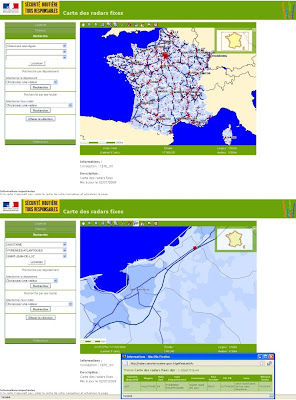
The Road Safety also provides information on the distribution of radar mobile departments. But it is not enough information to motorists themselves because the location of mobile cameras or temporary is not indicated.
Yesterday I saw on TV a story about warning systems and mapping called "collaborative" of traffic radar, designed to complement the information already available on the fixed cameras, information delivered by a "time Real "by motorists for mobile radars or temporary.
Thus, the system AlerteGPS offers motorists equipped with this system to send a warning to other motorists to alert them to any temporary or mobile radar. Immediately reported a radar, this information is broadcast via satellite or GPRS / UMTS to the databases of the device and then immediately rerun in near real time to all other motorists equipped with the same GPS system. They see then see a warning on their GPS equipment when they are near the camera and reported. But adding a new radar can also be done from the website of the company whose here here the result in the map interface:
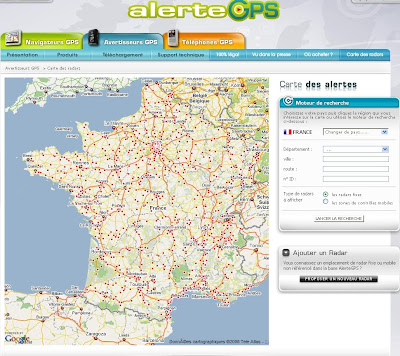
Another GPS, Coyote , offers a similar device called Coyote Mini :

This system, that is "the only alarm GPS of fixed and mobile radars "(voire. ..) works as a subscription. It also allows motorists who are equipped to report any temporary or mobile radar and disseminate this information in near real time by GSM to other motorists equipped with the same device and who have paid their subscription. The site
Radar mobiles.fr offers also a mapping of fixed and mobile radars based on Goole Maps that allows you to search by department, road and municipality. "The information contained on the site are either from a location on the ground or a ticket received by a user. You too can participate and enrich the database by submitting your sites with the category Add."
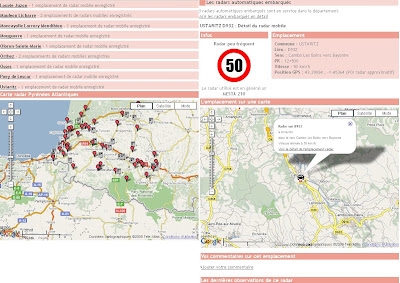
On 30 June, the City of Mazamet in the Tarn, organized the operation "12,000 lights for 12,000 lives saved on the road" . It aimed to highlight the achievements in road safety including reducing the number of deaths. On May 17, 1973, the same city Mazamet had hit the headlines with the operation "Mazamet wiped off the map" , organized with the Road Safety. During this operation , thousands of people grew long in the streets of the city. Last year, 16,170 people were killed on the roads and the people of this era Mazamet had 16 171 inhabitants. For fifteen minutes, people were lying Mazamet, silent and motionless, to illustrate the carnage. This was the launch of two slogans become Famous: "belt for life" and "driving, the sight that's life" .

(Copyright Road Safety)
can be found on the site of the INA some pictures of this in the show crossfire of September 26, 1973:
following years The number of dead had begun almost steady decrease as shown in this graph the annual number of fatalities in road accidents on the national network, available here on the site of Road Safety:
( Source Road Safety)
I tried to picture what had otherwise been in operation from 1973 Mazamet using the little guy from Google Maps, Pegman, and the representative of a reason to lie for 100 killed road at the time.
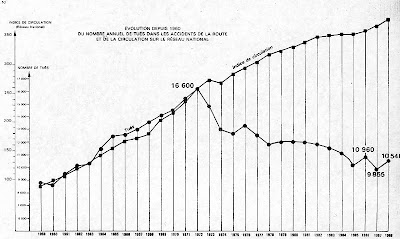
Today in France, the annual number of fatalities road approximately 4,200 people, or 12,000 lives saved since 1973, hence the operation Mazamet of 30 June. This is another way of representing the results, always keeping in image for the City of Mazamet which, seen from the sky might look like this, using the same Pegman, but standing this time, to symbolize the lives saved (a Pegman for 100 lives saved).
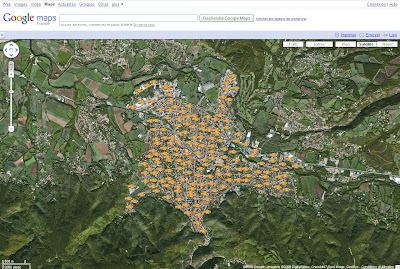
The Prefecture de Police de Paris has developed a mapping of accident cumulative (2006/2007/2008) of the Capital districts and for beltway.
This online mapping can also discover the intersections and sections of track the most accident.

(Copyright Prefecture de Police de Paris)
There are many other maps Internet of accident of French roads. Information exists and is now increasingly well known, especially in map form.
If you take the road today, but especially good holiday beware! 
To celebrate the first weekend of great holiday departures, the Road Safety expecting a massive influx of motorists on the roads of France.
For several years the number killed and injured in road transport continues to decline. How can we not rejoice? For specialists, this is certainly due, in large part, to the strengthening of political control by speed cameras that have flourished along the roads, particularly since the early 2000s.
The speed cameras are already well mapped, either on websites or in GPS in-vehicle navigation aid road. The Road Safety itself provides all the information about speed cameras and

The Road Safety also provides information on the distribution of radar mobile departments. But it is not enough information to motorists themselves because the location of mobile cameras or temporary is not indicated.
Yesterday I saw on TV a story about warning systems and mapping called "collaborative" of traffic radar, designed to complement the information already available on the fixed cameras, information delivered by a "time Real "by motorists for mobile radars or temporary.
Thus, the system AlerteGPS offers motorists equipped with this system to send a warning to other motorists to alert them to any temporary or mobile radar. Immediately reported a radar, this information is broadcast via satellite or GPRS / UMTS to the databases of the device and then immediately rerun in near real time to all other motorists equipped with the same GPS system. They see then see a warning on their GPS equipment when they are near the camera and reported. But adding a new radar can also be done from the website of the company whose here here the result in the map interface:

Another GPS, Coyote , offers a similar device called Coyote Mini :

This system, that is "the only alarm GPS of fixed and mobile radars "(voire. ..) works as a subscription. It also allows motorists who are equipped to report any temporary or mobile radar and disseminate this information in near real time by GSM to other motorists equipped with the same device and who have paid their subscription. The site
Radar mobiles.fr offers also a mapping of fixed and mobile radars based on Goole Maps that allows you to search by department, road and municipality. "The information contained on the site are either from a location on the ground or a ticket received by a user. You too can participate and enrich the database by submitting your sites with the category Add."

On 30 June, the City of Mazamet in the Tarn, organized the operation "12,000 lights for 12,000 lives saved on the road" . It aimed to highlight the achievements in road safety including reducing the number of deaths. On May 17, 1973, the same city Mazamet had hit the headlines with the operation "Mazamet wiped off the map" , organized with the Road Safety. During this operation , thousands of people grew long in the streets of the city. Last year, 16,170 people were killed on the roads and the people of this era Mazamet had 16 171 inhabitants. For fifteen minutes, people were lying Mazamet, silent and motionless, to illustrate the carnage. This was the launch of two slogans become Famous: "belt for life" and "driving, the sight that's life" .

(Copyright Road Safety)
can be found on the site of the INA some pictures of this in the show crossfire of September 26, 1973:
following years The number of dead had begun almost steady decrease as shown in this graph the annual number of fatalities in road accidents on the national network, available here on the site of Road Safety:
( Source Road Safety)
I tried to picture what had otherwise been in operation from 1973 Mazamet using the little guy from Google Maps, Pegman, and the representative of a reason to lie for 100 killed road at the time.

Today in France, the annual number of fatalities road approximately 4,200 people, or 12,000 lives saved since 1973, hence the operation Mazamet of 30 June. This is another way of representing the results, always keeping in image for the City of Mazamet which, seen from the sky might look like this, using the same Pegman, but standing this time, to symbolize the lives saved (a Pegman for 100 lives saved).

The Prefecture de Police de Paris has developed a mapping of accident cumulative (2006/2007/2008) of the Capital districts and for beltway.
This online mapping can also discover the intersections and sections of track the most accident.

(Copyright Prefecture de Police de Paris)
There are many other maps Internet of accident of French roads. Information exists and is now increasingly well known, especially in map form.
If you take the road today, but especially good holiday beware!
Thursday, July 2, 2009
Does Open Hole Knee Braces Work
Similar Images of Google Labs
World Géonumérique On his blog, Thierry Joliveau recently presented here results on keywords and names related geomatics tool from Google Trends Google. Google Trends analyzes the frequency before a keyword into the Google search engine and provides statistical results chronological and geographical such as graphs. This tool is part of those developed in Google Labs . I've done some tests show the great variation in results by spelling words entered, which does not mean that the tool is fully discredit.
It is another tool of Google Labs, which interested me was Similar Images .
Better too long an explanation, here is the video presentation of one of the project at Google Similar Images:
Similar Images lets you search more images using image content themselves that the words associated with images. As its name suggests, focuses Similar Images find similarities in the images. Google talk instead of using "visual similarity". Following a query, a results page is displayed as one can get with the feature "classic" image search "Google.
The first example below shows the results obtained with Similar images for the keyword "France Map"

We can compare this result with that obtained with the tool "classic" "Search Images "Google:

Like the classic image search in Google, the query results are displayed as thumbnail images. It is then possible, from the menus provided for this purpose at the top of the page, select only the images of a certain size (small, medium, large, very large) or corresponding to a certain type of content (news, faces, clip art, line drawing, photo content), or by dominant color among 12 colors available. The major advantage of
Similar Images is to propose some thumbnails of the results obtained by the query, a link "Similar Images" . This link provides access to images considered similar, which also appear in the top banner after clicking a thumbnail. This feature can be very helpful to sort among the immediate results of his first complaint. Thus, in the example below the results appear to "Paris" after selecting only images of maps of Paris suggested by the link "Similar Images":

This avoids, in particular, fall images of ... Paris Hilton ...

But just like Google Trends Similar Images is very sensitive to spelling or the order of the keywords entered. Thus, in the example below, depending on whether one takes "satellite images" (above) or "satellite images" (bottom), results may differ materially.

Many other applications are looking for content, either on audio, video, text, etc.. eg TinEye or Voxalead . Google was not the exclusivity of this kind of functionality, but we know the "strike force" of the Mountain View company when she decided to pursue investment significant research and development.
Finally, how can we not question the quality and relevance of results obtained with "Similar Images" when searching for "pictures like" Michael Jackson, the man whose face image does ceased to change throughout his life ... 
World Géonumérique On his blog, Thierry Joliveau recently presented here results on keywords and names related geomatics tool from Google Trends Google. Google Trends analyzes the frequency before a keyword into the Google search engine and provides statistical results chronological and geographical such as graphs. This tool is part of those developed in Google Labs . I've done some tests show the great variation in results by spelling words entered, which does not mean that the tool is fully discredit.
It is another tool of Google Labs, which interested me was Similar Images .
Better too long an explanation, here is the video presentation of one of the project at Google Similar Images:
Similar Images lets you search more images using image content themselves that the words associated with images. As its name suggests, focuses Similar Images find similarities in the images. Google talk instead of using "visual similarity". Following a query, a results page is displayed as one can get with the feature "classic" image search "Google.
The first example below shows the results obtained with Similar images for the keyword "France Map"

We can compare this result with that obtained with the tool "classic" "Search Images "Google:

Like the classic image search in Google, the query results are displayed as thumbnail images. It is then possible, from the menus provided for this purpose at the top of the page, select only the images of a certain size (small, medium, large, very large) or corresponding to a certain type of content (news, faces, clip art, line drawing, photo content), or by dominant color among 12 colors available. The major advantage of
Similar Images is to propose some thumbnails of the results obtained by the query, a link "Similar Images" . This link provides access to images considered similar, which also appear in the top banner after clicking a thumbnail. This feature can be very helpful to sort among the immediate results of his first complaint. Thus, in the example below the results appear to "Paris" after selecting only images of maps of Paris suggested by the link "Similar Images":

This avoids, in particular, fall images of ... Paris Hilton ...

But just like Google Trends Similar Images is very sensitive to spelling or the order of the keywords entered. Thus, in the example below, depending on whether one takes "satellite images" (above) or "satellite images" (bottom), results may differ materially.

Many other applications are looking for content, either on audio, video, text, etc.. eg TinEye or Voxalead . Google was not the exclusivity of this kind of functionality, but we know the "strike force" of the Mountain View company when she decided to pursue investment significant research and development.
Finally, how can we not question the quality and relevance of results obtained with "Similar Images" when searching for "pictures like" Michael Jackson, the man whose face image does ceased to change throughout his life ...
Wednesday, July 1, 2009
Women Weting Themsleves
Georeferencing of cultural heritage in France
To celebrate its 50 years, the Ministry of Culture has given the company Hyptique (which has, in the other CD-Roms "Land of Cities" published by Belin and which I recently here talked ) a website dedicated to this event .
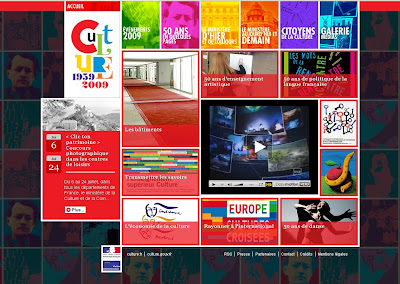
(Copyright Ministry of Culture)
Rubric "Citizens of Culture can find a map of France, using Google Maps, which locates photographs of many places and events illustrating the wealth national cultural in many forms.
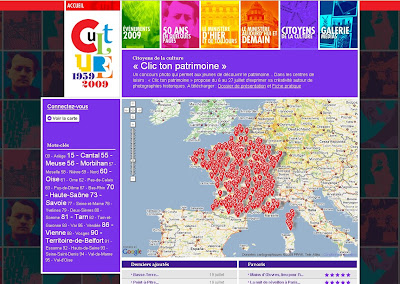
(Copyright Ministry of Culture)
By clicking on each icon, one can see a photograph and explanatory text. I had the privilege to participate in the testing phase of this section and deposit some contributions including one on House of Pierre Loti in Rochefort which I mentioned here .
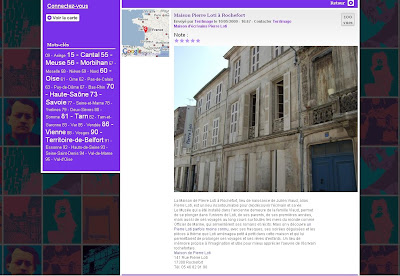
(Copyright Ministry of Culture)
Originally designed to allow any user to file its own pictures and comments on these places of cultural heritage, the Ministry of Culture has returned to a less "participatory "This section would have allowed the spontaneous georeferencing of much of" heritage "French but with problems of definition and right images and their objects, not to mention the tremendous work of moderate contributions may be underestimated initially. Finally the Ministry of Culture has decided to limit this to a heritage map operation called "Click your heritage" . This is a photo contest organized in partnership with the High Committee for youth between 6 and 24 July, which should enable young people attending the summer recreation centers to learn about photography. "Designed by Francoise Denoyelle, professor at the Institut Louis-Lumière, the contest will take participants to set up a photographic inspired by those of Christmas The Boyer and Georges Arlaud which, in the twentieth century, have traveled France with their device. This new photographic body born of the competition will be paid at the Library of Architecture and Heritage in the European Heritage Days 19 and 20 September. ".
already exist to other sites of the Ministry of Culture which can discover the cultural heritage through an inlet or geographical mapping from databases developed over the years such as the base Mérimée.
This site "Architecture and Heritage" to discover the outcome of the heritage inventory cultural, historic monuments, and library of Architecture and Heritage . The site
"Architecture and Heritage" provides access to geographical data from the Inventory of heritage whose geographical basis of the work is across the township. "Investigations into the field by the researchers in charge of the inventory are grouped within a department, then by all township buildings or objects, then by individual work folders" . .
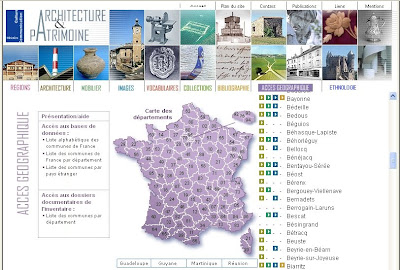
(Copyright Ministry of Culture)
Data access is done by departments and municipalities for which there is an indication of the nature of the data available and searchable online.

(Copyright Ministry of Culture)
Clicking on old photographs available online you can discover not only the photographic heritage but also find images of places or landmarks that still exist today or and can then compare to current views, whether his own photographs, those of others available in Panoramio, or with images or aerial views ground available in the various mapping sites online.

(Top View Theatre of Bayonne and the Adour early twentieth century, Copyright Ministry of Culture, Media architecture and heritage - Diffusion NMR. Bottom view taken by me Christmas in 2007 during the Bayonne)
course, these few examples shown do not claim completeness of the present achievements and current projects of the Ministry of Culture in mapping and georeferencing of cultural heritage. In addition, the Ministry of Culture is not the only player in the French cultural heritage, since local authorities, associations, and numerous institutions working for the protection and enhancement of cultural heritage, a valuation that now happening more and more by an Internet presence, including by geographical discovery and mapping. 
To celebrate its 50 years, the Ministry of Culture has given the company Hyptique (which has, in the other CD-Roms "Land of Cities" published by Belin and which I recently here talked ) a website dedicated to this event .

(Copyright Ministry of Culture)
Rubric "Citizens of Culture can find a map of France, using Google Maps, which locates photographs of many places and events illustrating the wealth national cultural in many forms.

(Copyright Ministry of Culture)
By clicking on each icon, one can see a photograph and explanatory text. I had the privilege to participate in the testing phase of this section and deposit some contributions including one on House of Pierre Loti in Rochefort which I mentioned here .

(Copyright Ministry of Culture)
Originally designed to allow any user to file its own pictures and comments on these places of cultural heritage, the Ministry of Culture has returned to a less "participatory "This section would have allowed the spontaneous georeferencing of much of" heritage "French but with problems of definition and right images and their objects, not to mention the tremendous work of moderate contributions may be underestimated initially. Finally the Ministry of Culture has decided to limit this to a heritage map operation called "Click your heritage" . This is a photo contest organized in partnership with the High Committee for youth between 6 and 24 July, which should enable young people attending the summer recreation centers to learn about photography. "Designed by Francoise Denoyelle, professor at the Institut Louis-Lumière, the contest will take participants to set up a photographic inspired by those of Christmas The Boyer and Georges Arlaud which, in the twentieth century, have traveled France with their device. This new photographic body born of the competition will be paid at the Library of Architecture and Heritage in the European Heritage Days 19 and 20 September. ".
already exist to other sites of the Ministry of Culture which can discover the cultural heritage through an inlet or geographical mapping from databases developed over the years such as the base Mérimée.
This site "Architecture and Heritage" to discover the outcome of the heritage inventory cultural, historic monuments, and library of Architecture and Heritage . The site
"Architecture and Heritage" provides access to geographical data from the Inventory of heritage whose geographical basis of the work is across the township. "Investigations into the field by the researchers in charge of the inventory are grouped within a department, then by all township buildings or objects, then by individual work folders" . .

(Copyright Ministry of Culture)
Data access is done by departments and municipalities for which there is an indication of the nature of the data available and searchable online.

(Copyright Ministry of Culture)
Clicking on old photographs available online you can discover not only the photographic heritage but also find images of places or landmarks that still exist today or and can then compare to current views, whether his own photographs, those of others available in Panoramio, or with images or aerial views ground available in the various mapping sites online.

(Top View Theatre of Bayonne and the Adour early twentieth century, Copyright Ministry of Culture, Media architecture and heritage - Diffusion NMR. Bottom view taken by me Christmas in 2007 during the Bayonne)
course, these few examples shown do not claim completeness of the present achievements and current projects of the Ministry of Culture in mapping and georeferencing of cultural heritage. In addition, the Ministry of Culture is not the only player in the French cultural heritage, since local authorities, associations, and numerous institutions working for the protection and enhancement of cultural heritage, a valuation that now happening more and more by an Internet presence, including by geographical discovery and mapping.
Tuesday, June 30, 2009
Creatine Monohydrate Cold Sores
Two Tour de France quite different
From Saturday 4 to Sunday, July 26, 2009 will be held on the 96th Tour de France 2009 , which includes 21 steps for a distance of approximately 3500 kilometers.
How can you resist the urge to show the animation map of the route to be followed this year by riders and caravan
On the official website of the "Great Loop," the Tour 2009 is reproduced on a relief map in colors yellow color of the jersey requires the winner.

(Copyright ASO)
map Tour has even been reproduced on a T-shirt "ESSENTIAL!" (20 € Map ... still is money).

(Copyright ASO)
plots of each step gives rise to map illustrations that rely on mapping Geoatlas example below for the first step Monaco -> Monaco:

(Copyright ASO)
The profiles are also available:

(Copyright ASO) You will find here
file. kml that tracks the Tour in Google Earth, step by step. Of course, the course has also been reproduced on Google Maps as a whole ...

... and step by step:

There is also a Flash version here:

Personally, for several years, my preference is for another Tour de France: "Tour de France with two children" , a reader of Augustine Fouillee school, called G. Bruno, published for the first time in 1877 and I have a copy from me that read and reread "staged".

This book was a huge best-seller (8.6 million copies sold), especially because he was "adopted and recommended for school libraries and on the list of books donated by the City of Paris to its municipal schools. .
Can be found here on the site of an article by Valerie Clionautes Fossar, a sort of critical summary of the book, which I borrow the opening lines:
"Through reading the adventures of two young orphans Lorraine, whose ages foster an identification process for students to cycle 3 (Julian is 7 years old) and college (Andrew 14), the book discusses the history of France from its "big characters" yet studied school today (Vercingetorix, Joan of Arc, ...) but also provides information on the nineteenth-century France, between industrialization (...) More traditional crafts and highlighted by the story (...). It depicts a society committed to values constantly reminded of sub-chapter headings (...)".
can also find here an article by J. and M. Ozouf "The Tower France by two children, The Little Red Book of the Republic " ( in places of memory, Book I: The Republic, under the direction of Pierre Nora, Paris, Gallimard, 1984).
can be found here , free full text and illustrations for several publications including the 1877 and 1923. When comparing the two editions, it is interesting to note the deletion of any reference to God, religion, its manifestations, its monuments, which occurred from the 1906 edition, after the promulgation of the 1905 Act on the separation of church and State .
The book contains twenty maps of regions of France covered by the two children, listed in an index card. A gazetteer of place names mentioned in the text is also available.
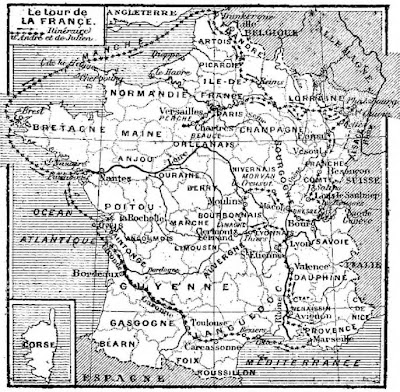
(Source here )
From this map of a Tour de France, certainly from another era, but was released for free child and that of the next Tour de France which costs 20 € for the version printed on t-shirt, my preference is definitely the first ... 
From Saturday 4 to Sunday, July 26, 2009 will be held on the 96th Tour de France 2009 , which includes 21 steps for a distance of approximately 3500 kilometers.
How can you resist the urge to show the animation map of the route to be followed this year by riders and caravan
On the official website of the "Great Loop," the Tour 2009 is reproduced on a relief map in colors yellow color of the jersey requires the winner.

(Copyright ASO)
map Tour has even been reproduced on a T-shirt "ESSENTIAL!" (20 € Map ... still is money).

(Copyright ASO)
plots of each step gives rise to map illustrations that rely on mapping Geoatlas example below for the first step Monaco -> Monaco:

(Copyright ASO)
The profiles are also available:

(Copyright ASO) You will find here
file. kml that tracks the Tour in Google Earth, step by step. Of course, the course has also been reproduced on Google Maps as a whole ...

... and step by step:

There is also a Flash version here:

Personally, for several years, my preference is for another Tour de France: "Tour de France with two children" , a reader of Augustine Fouillee school, called G. Bruno, published for the first time in 1877 and I have a copy from me that read and reread "staged".

This book was a huge best-seller (8.6 million copies sold), especially because he was "adopted and recommended for school libraries and on the list of books donated by the City of Paris to its municipal schools. .
Can be found here on the site of an article by Valerie Clionautes Fossar, a sort of critical summary of the book, which I borrow the opening lines:
"Through reading the adventures of two young orphans Lorraine, whose ages foster an identification process for students to cycle 3 (Julian is 7 years old) and college (Andrew 14), the book discusses the history of France from its "big characters" yet studied school today (Vercingetorix, Joan of Arc, ...) but also provides information on the nineteenth-century France, between industrialization (...) More traditional crafts and highlighted by the story (...). It depicts a society committed to values constantly reminded of sub-chapter headings (...)".
can also find here an article by J. and M. Ozouf "The Tower France by two children, The Little Red Book of the Republic " ( in places of memory, Book I: The Republic, under the direction of Pierre Nora, Paris, Gallimard, 1984).
can be found here , free full text and illustrations for several publications including the 1877 and 1923. When comparing the two editions, it is interesting to note the deletion of any reference to God, religion, its manifestations, its monuments, which occurred from the 1906 edition, after the promulgation of the 1905 Act on the separation of church and State .
The book contains twenty maps of regions of France covered by the two children, listed in an index card. A gazetteer of place names mentioned in the text is also available.

(Source here )
From this map of a Tour de France, certainly from another era, but was released for free child and that of the next Tour de France which costs 20 € for the version printed on t-shirt, my preference is definitely the first ...
Monday, June 29, 2009
Dongle Emulator For Sentinel Ultrapro
The news: a vision of the world for 60 years
In June 1949, the first newscast (JT) appeared on the screens of some TV stations that existed in homes. These days, presenters current JT celebrate this anniversary in their own way by inviting their colleagues the best known, "institutions" in the art. For its part, the INA provides on its site Audiovisual Archives ("makeover" for some time) many sequences JT for 60 years.
The JT is now a prominent place in the "cosmogony" collective societies, at least in countries where access to television is largely assured. The images broadcast on JT do not just round the world: they "make" the world. The "truth" out now from the mouths of presenters, reporters and cameras of reporters. "But they have said the information!" : Is not that a common currency is meant, thrust as an incontrovertible truth, claiming itself to guarantee the sincerity and credibility of everything that is said and shown at JT?
images of the world now spend on our screens in a loop and now on our computer stations via Internet. And as to drive the nail, specialty channels of information have emerged since the last few years, passing loop every 15 minutes, may cause us to swim in a sort of "saturation informational" dubbed a "tyranny of instant information, "a broadcast anywhere, any time, images of the world live. The information then becomes totalizing and purely emotional, she abandons the field of explanation, back and took time to understand and yield to the temptation of "image manipulation" which explains nothing because it only seeks to move. The "risk totalitarian" never gets very far. This reign of the immediacy of modern times is particularly denounced by Paul Virilio in "The rate of release" where he talks about the world as "Télécité interconnected" introducing new pollution called dromosphérique "(Greek dromos which means race).
As for the supposed "objectivity and impartiality" of journalists, those of JT and the other a long time ago that this illusion has been unmasked and denied, in particular by Serge Halimi "The new watchdogs .
To return to JT, I discovered with amusement that the first images sent back to the first JT, were taken from a camera mounted on a balloon that eventually ... in a tree and partially burned.
can discover the first images on the site of the INA, but here's a preview aired yesterday JT France 3. This is an aerial image of the Hotel des Invalides in Paris:
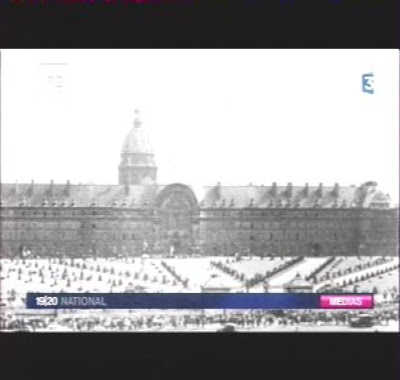
(Copyright France3 INA)
See the world from the sky is a perspective chosen from the beginning by JT. It is not surprising then to use excessive and sometimes aerial and satellite images in the JT today such as the aerial image simulated perspective recently used to highlight the schools of the 15th arrondissement of Paris who have been affected by the epidemic of influenza A. I always wonder what journalists have tried to explain this using aerial imagery rather than a conventional plan ... Satellite and aerial imagery would it becoming a sort of locator reference for journalists, willing victims of the "googlomapisation" of the world?
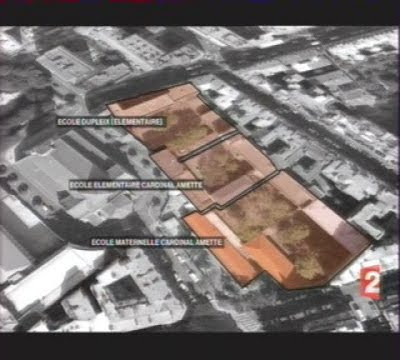
(Copyright France2)
What I have also been arrested in the brief history released yesterday was the use and staging, early on, an animated globe in the generic and JT a large globe in the background of submitting JT:
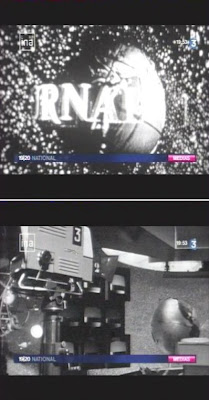
(Copyright France3 INA)
Today we find the use of globes and maps in the animation studios and scenery many JT.
I take this note to indicate that the site of the INA provides here georeferencing of some of its audiovisual archives:

(Copyright INA)
geolocation This archive is based on Google Maps . For now, very few archives have been so géoréférencéees but we imagine that the card will fill up gradually.
access to cartographic archive INA is also available in some cases the site of the INA (in addition to access through a timeline), for example, in the case "Milestones Mediterranean" :

(Copyright INA)
Some contents of the INA are already available on the IGN Geoportal :
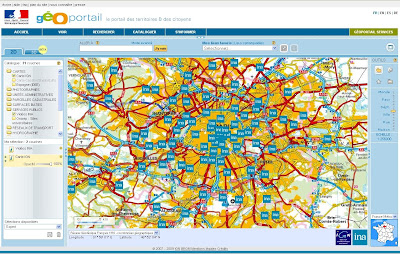
(Copyright IGN. Click here to access )
"In the 2D visualization interface Geoportal, choose Expert profile, open the theme Utilities and click on the layer Videos INA.
From 1:500 000 scale, the INA pictograms are displayed. Click on a pictogram. An information sheet gives you access to a dozen video clips related to the city your choice. The program is diverse and varied news.
A link also provides access to the site of the INA for those who want to know more on selected excerpts. And eventually, all towns in France have their "video memories".
Unfortunately, for now, all records are unavailable and a superb "Error 404: Page Not Found" appears inexorably .. . "Looking for something on Ina.fr? The page you tried to reach was not found. You may have used a link too old or you have typed the address (URL) incorrectly. " This is also the risk with instant information: that his life is never very long and that the links between information, principle of using the Internet, quickly becoming too old ... 
In June 1949, the first newscast (JT) appeared on the screens of some TV stations that existed in homes. These days, presenters current JT celebrate this anniversary in their own way by inviting their colleagues the best known, "institutions" in the art. For its part, the INA provides on its site Audiovisual Archives ("makeover" for some time) many sequences JT for 60 years.
The JT is now a prominent place in the "cosmogony" collective societies, at least in countries where access to television is largely assured. The images broadcast on JT do not just round the world: they "make" the world. The "truth" out now from the mouths of presenters, reporters and cameras of reporters. "But they have said the information!" : Is not that a common currency is meant, thrust as an incontrovertible truth, claiming itself to guarantee the sincerity and credibility of everything that is said and shown at JT?
images of the world now spend on our screens in a loop and now on our computer stations via Internet. And as to drive the nail, specialty channels of information have emerged since the last few years, passing loop every 15 minutes, may cause us to swim in a sort of "saturation informational" dubbed a "tyranny of instant information, "a broadcast anywhere, any time, images of the world live. The information then becomes totalizing and purely emotional, she abandons the field of explanation, back and took time to understand and yield to the temptation of "image manipulation" which explains nothing because it only seeks to move. The "risk totalitarian" never gets very far. This reign of the immediacy of modern times is particularly denounced by Paul Virilio in "The rate of release" where he talks about the world as "Télécité interconnected" introducing new pollution called dromosphérique "(Greek dromos which means race).
As for the supposed "objectivity and impartiality" of journalists, those of JT and the other a long time ago that this illusion has been unmasked and denied, in particular by Serge Halimi "The new watchdogs .
To return to JT, I discovered with amusement that the first images sent back to the first JT, were taken from a camera mounted on a balloon that eventually ... in a tree and partially burned.
can discover the first images on the site of the INA, but here's a preview aired yesterday JT France 3. This is an aerial image of the Hotel des Invalides in Paris:

(Copyright France3 INA)
See the world from the sky is a perspective chosen from the beginning by JT. It is not surprising then to use excessive and sometimes aerial and satellite images in the JT today such as the aerial image simulated perspective recently used to highlight the schools of the 15th arrondissement of Paris who have been affected by the epidemic of influenza A. I always wonder what journalists have tried to explain this using aerial imagery rather than a conventional plan ... Satellite and aerial imagery would it becoming a sort of locator reference for journalists, willing victims of the "googlomapisation" of the world?

(Copyright France2)
What I have also been arrested in the brief history released yesterday was the use and staging, early on, an animated globe in the generic and JT a large globe in the background of submitting JT:

(Copyright France3 INA)
Today we find the use of globes and maps in the animation studios and scenery many JT.
I take this note to indicate that the site of the INA provides here georeferencing of some of its audiovisual archives:

(Copyright INA)
geolocation This archive is based on Google Maps . For now, very few archives have been so géoréférencéees but we imagine that the card will fill up gradually.
access to cartographic archive INA is also available in some cases the site of the INA (in addition to access through a timeline), for example, in the case "Milestones Mediterranean" :

(Copyright INA)
Some contents of the INA are already available on the IGN Geoportal :

(Copyright IGN. Click here to access )
"In the 2D visualization interface Geoportal, choose Expert profile, open the theme Utilities and click on the layer Videos INA.
From 1:500 000 scale, the INA pictograms are displayed. Click on a pictogram. An information sheet gives you access to a dozen video clips related to the city your choice. The program is diverse and varied news.
A link also provides access to the site of the INA for those who want to know more on selected excerpts. And eventually, all towns in France have their "video memories".
Unfortunately, for now, all records are unavailable and a superb "Error 404: Page Not Found" appears inexorably .. . "Looking for something on Ina.fr? The page you tried to reach was not found. You may have used a link too old or you have typed the address (URL) incorrectly. " This is also the risk with instant information: that his life is never very long and that the links between information, principle of using the Internet, quickly becoming too old ...
Top Ecchi, Harem Anime List
noise maps
2002/49/EC European Directive on the assessment and management of environmental noise (transposed into French law by ordinance ratified by the Act of 26 October 2005 implementing decree No. 2006 - 361, OJ of 26 March 2006 and now included in the Code of Environment) aims, through strategic noise maps to assess in a harmonized way the exposure to noise in the 25 member states. The strategic noise mapping allows a representation of noise levels, to count the population exposed to quantify nuisances and to develop action plans (preservation of quiet areas). The noise maps are developed for large infrastructure and major cities.
For example, here are strategic noise maps of the town of Chalifert , Seine et Marne, developed in partnership with the General Council:

(Source Wikipedia )
Data global (multi-map displays) show that the common Chalifert is primarily exposed to rail noise. The road noise is present in a diffuse and moderate in the territory of the commune. In contrast, the population is not exposed to industrial noise and air, at least according to the criteria of mapping considered in the context of the implementation of European Directive.
Other municipalities have produced maps of noise as the Saint-Etienne example that has given these studies to the company Acouphen Environment:

"The goal is to preserve and improve health and quality of life of people and to include consideration of noise in urban policies in a context of sustainable development. "
bad this interactive mapping online tool does not zoom.
Meanwhile, the BBC has a sound card in the world that has nothing to do with the previous noise maps. This is an open project to users where anyone can submit a sound recording of a few seconds or minutes from anywhere in the world. The objective is to obtain a global map of geo-referenced sounds. This project called "Save Our Sounds" based on the online mapping service from Microsoft, Bing Maps (formerly Virtual Earth):

For now, for France, contributions are limited and focus mainly on Paris:

For lovers of sound cards from a totally different kind, the film Map of the Sounds of Tokyo directed by Isabel Coixet with Rinko Kikuchi, Sergi López, Min Tanaka, who was presented in official competition at Cannes, is soon out on movie screens in France.

(© 2009. MEDIAPRODUCCIÓN SL, Versatile CINEMA SL)
Until its release, you can always discover the first images and extracts from the soundtrack to the film site . One can think here of films like "Lost in Translation" by Sofia Coppola or some of the films of Wong Kar Wai, where the soundtrack plays a particular role. 
2002/49/EC European Directive on the assessment and management of environmental noise (transposed into French law by ordinance ratified by the Act of 26 October 2005 implementing decree No. 2006 - 361, OJ of 26 March 2006 and now included in the Code of Environment) aims, through strategic noise maps to assess in a harmonized way the exposure to noise in the 25 member states. The strategic noise mapping allows a representation of noise levels, to count the population exposed to quantify nuisances and to develop action plans (preservation of quiet areas). The noise maps are developed for large infrastructure and major cities.
For example, here are strategic noise maps of the town of Chalifert , Seine et Marne, developed in partnership with the General Council:

(Source Wikipedia )
Data global (multi-map displays) show that the common Chalifert is primarily exposed to rail noise. The road noise is present in a diffuse and moderate in the territory of the commune. In contrast, the population is not exposed to industrial noise and air, at least according to the criteria of mapping considered in the context of the implementation of European Directive.
Other municipalities have produced maps of noise as the Saint-Etienne example that has given these studies to the company Acouphen Environment:

"The goal is to preserve and improve health and quality of life of people and to include consideration of noise in urban policies in a context of sustainable development. "
bad this interactive mapping online tool does not zoom.
Meanwhile, the BBC has a sound card in the world that has nothing to do with the previous noise maps. This is an open project to users where anyone can submit a sound recording of a few seconds or minutes from anywhere in the world. The objective is to obtain a global map of geo-referenced sounds. This project called "Save Our Sounds" based on the online mapping service from Microsoft, Bing Maps (formerly Virtual Earth):

For now, for France, contributions are limited and focus mainly on Paris:

For lovers of sound cards from a totally different kind, the film Map of the Sounds of Tokyo directed by Isabel Coixet with Rinko Kikuchi, Sergi López, Min Tanaka, who was presented in official competition at Cannes, is soon out on movie screens in France.

(© 2009. MEDIAPRODUCCIÓN SL, Versatile CINEMA SL)
Until its release, you can always discover the first images and extracts from the soundtrack to the film site . One can think here of films like "Lost in Translation" by Sofia Coppola or some of the films of Wong Kar Wai, where the soundtrack plays a particular role.
Sunday, June 28, 2009
List Two Allusions To Romeo And Juliet
Two ancient geography journals for the general public: Geographia Atlas
The "accident" made me find today on one of the fastest known second-hand books of Paris, the numbers of the former journal Geographia, published in the 50 and 60. This review, which I can not tell what was the publisher no longer exists. It has nothing to do with the current review Geography of the Geographical Society which I have already mentioned several recent issues and "facelift" for 18 months or with predecessors of this review.

In the issue I bought (No. 81 of June 1958), we find a fascinating article by Andre Libault (the 5th article of a series on the History of Cartography ) for on the projection and the line to the clipboard; This article is in fact the occasion of a synthetic history and teaching of Western cartography where mention is made of portolans Portuguese, school mapping Dutch maps Elizabethan Neptune françois or globes of Coronelli.
can find back issues of this magazine to purchase online on specialized sites like this one . Other
journal found by "chance": " Atlas" with the subtitle "Discovering world." This is a monthly journal published by Editions Atlas and prestigious committee of reference "(Scientific Committee): Andre de Cayeux, Yves Coppens, Roger Frisian-Roche, Louis Leprince-Ringuet, Andre Leroi-Gourhan, Jean Rostand, Haroun Tazieff, Paul-Emile Victor, etc..
I managed to get the number 1, dated January 1977:

Contents of this Number 1, an article entitled "The land of men from a plane" , text and Eugene Turri Photo by Georg Gerster sort of ode to the earth and its extraordinary shapes and colors from the sky, long before the recent publications by Yann Arthus-Bertrand.
addition to superb aerial photographs of various backgrounds and comments that accomapgnent, this article offers some "Tips for a better look" that provide the information necessary for a passenger on an airliner to choose the best location: "With a little trial, it is possible to find" bonn displaces. "That is to say that even before boarding you have to pick one from which it will be possible in the best conditions to see what interests you. It goes without saying that the first condition is to find a place near a window. Everyone can, to some extent, by observing a map and taking into account the route will follow the device, "project" his flight. "
I do not resist the urge to quote the last lines of the article:
"From up there, we do not distinguish the sign of Man, the materialization of the relationship between man and nature, not feelings and ideas, for this report, are connected and linked together. Feelings and ideas that we can not exclude that an interim basis, our "Geoscope" can not be reduced to entomology, as if the signs left by human activity were only traces of insects. Basically, air travel is a bit like a break, a dream, a respite, after which we feel better still clinging to our city, our neighborhood, in our earthly reality. "
Unless I am mistaken, I think these two magazines have disappeared. They have been replaced by magazines such as GEO , National Geographic French version Geography , "Great News" , "Wild Earth" , "Detours in France" .
to believe the studies on the distribution of national newspapers and magazines in particular, it would cross over several years an unprecedented crisis. Thus, the category of "Press Travel, Gastronomy, Tourism and Transport where you can store most of the magazines mentioned above, shows a net decline since 2002 and continuing.

(Source OJD)
The only glimmer of hope in this bleak horizon: the "Second Life" magazines, the sale after their publication ("Release Delayed") has the effect of Internet sales of back issues no longer on the newsstands as shown in the diagram from the study of 18th Observatoire de la Presse, a trend confirmed by the 19th Press Observatory (Observatoire de la Presse is the annual event of the French press that gives an overview of the press From the analysis of scattering data of over 1000 titles of OJD , Association for the control of media distribution).
What is surprising is that despite all this mess in the economy of the magazine, some new titles appear as such Traveller. A mind elsewhere " I recently discovered. 
The "accident" made me find today on one of the fastest known second-hand books of Paris, the numbers of the former journal Geographia, published in the 50 and 60. This review, which I can not tell what was the publisher no longer exists. It has nothing to do with the current review Geography of the Geographical Society which I have already mentioned several recent issues and "facelift" for 18 months or with predecessors of this review.

In the issue I bought (No. 81 of June 1958), we find a fascinating article by Andre Libault (the 5th article of a series on the History of Cartography ) for on the projection and the line to the clipboard; This article is in fact the occasion of a synthetic history and teaching of Western cartography where mention is made of portolans Portuguese, school mapping Dutch maps Elizabethan Neptune françois or globes of Coronelli.
can find back issues of this magazine to purchase online on specialized sites like this one . Other
journal found by "chance": " Atlas" with the subtitle "Discovering world." This is a monthly journal published by Editions Atlas and prestigious committee of reference "(Scientific Committee): Andre de Cayeux, Yves Coppens, Roger Frisian-Roche, Louis Leprince-Ringuet, Andre Leroi-Gourhan, Jean Rostand, Haroun Tazieff, Paul-Emile Victor, etc..
I managed to get the number 1, dated January 1977:

Contents of this Number 1, an article entitled "The land of men from a plane" , text and Eugene Turri Photo by Georg Gerster sort of ode to the earth and its extraordinary shapes and colors from the sky, long before the recent publications by Yann Arthus-Bertrand.
addition to superb aerial photographs of various backgrounds and comments that accomapgnent, this article offers some "Tips for a better look" that provide the information necessary for a passenger on an airliner to choose the best location: "With a little trial, it is possible to find" bonn displaces. "That is to say that even before boarding you have to pick one from which it will be possible in the best conditions to see what interests you. It goes without saying that the first condition is to find a place near a window. Everyone can, to some extent, by observing a map and taking into account the route will follow the device, "project" his flight. "
I do not resist the urge to quote the last lines of the article:
"From up there, we do not distinguish the sign of Man, the materialization of the relationship between man and nature, not feelings and ideas, for this report, are connected and linked together. Feelings and ideas that we can not exclude that an interim basis, our "Geoscope" can not be reduced to entomology, as if the signs left by human activity were only traces of insects. Basically, air travel is a bit like a break, a dream, a respite, after which we feel better still clinging to our city, our neighborhood, in our earthly reality. "
Unless I am mistaken, I think these two magazines have disappeared. They have been replaced by magazines such as GEO , National Geographic French version Geography , "Great News" , "Wild Earth" , "Detours in France" .
to believe the studies on the distribution of national newspapers and magazines in particular, it would cross over several years an unprecedented crisis. Thus, the category of "Press Travel, Gastronomy, Tourism and Transport where you can store most of the magazines mentioned above, shows a net decline since 2002 and continuing.

(Source OJD)
The only glimmer of hope in this bleak horizon: the "Second Life" magazines, the sale after their publication ("Release Delayed") has the effect of Internet sales of back issues no longer on the newsstands as shown in the diagram from the study of 18th Observatoire de la Presse, a trend confirmed by the 19th Press Observatory (Observatoire de la Presse is the annual event of the French press that gives an overview of the press From the analysis of scattering data of over 1000 titles of OJD , Association for the control of media distribution).
What is surprising is that despite all this mess in the economy of the magazine, some new titles appear as such Traveller. A mind elsewhere " I recently discovered.
Subscribe to:
Posts (Atom)